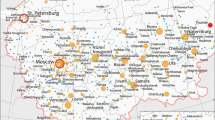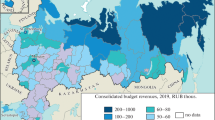Abstract
Social planning requires the application of indicators as instruments for the measuring of phenomena and processes, for monitoring, and for evaluation.
The spatial polarization of socio-economic growth together with individual regional features lead to the emergence of considerable differentiations and disparities. Many of them are perceived in social consciousness as ineqities which require equalization, e.g. living conditions in the sphere of satisfaction of elementary social needs.
In order to be effective, social planning must take account of, among other things, the hierarchy of centres and institutions for satisfying social needs, which most frequently amounts to 3 ranks of service (local, regional, national). Each region possesses its own central area (centre) and peripheral area (periphery). The differences between them amount to the emergence of changing socio-economic structures together with a changing dynamic in development and rate of economic growth. The gradation of social needs comprised in social planning corresponds to the hierarchy of service centres.
Regional indicators serve the analysis of inter-regional disparities as related to the external “model system”, and are most frequently national means, as well as of intraregional disparities as related to the internal “model system”, which are represented by means of separate regions. The selection of an appropriate set of regional indicators requires a lot of attention. The paper points up the danger of the application of inappropriate regional indicators, which cause distortions in the spatial picture of differentiations.
Similar content being viewed by others
Bibliography
Klaassen, L. and Paelinck, J.: 1971, Integration of Socio-Economic and Physical Planning (Rotterdam University Press, Rotterdam).
Cox, K. R., Reynolds, D. R., and Rokkan, S. (eds.): 1974, Locational Approaches to Power and Conflict (Sage, New York).
Friedmann, J.: 1979, Good Society (MIT Press, Cambridge).
Higgins, B.: 1977, ‘Social aspects of regional planning’, in: Kuklinski, A. (ed.), Social Issues in Regional Policy and Regional Planning (Mouton, The Hague, Paris), pp. 189–194 (New Babylon Studies in the Social Sciences, vol. 27).
Friedmann, J.: 1979, ‘Unequal development and the crisis of transition’, Development and Change 10, pp. 125–153.
Coraggio, J. L.: 1981, ‘Polarization, development, and integration’, in Kuklinski, A. (ed.), Polarized Development and Regional Policies (Mouton, The Hague, Paris), pp. 37–57.
Pióro, Z.: 1977, ‘A sociological concept of polarized development’, in: Kuklinski, A. (ed.), Social Issues in Regional Policy and Regional Planning (Mouton, The Hague, Paris), pp. 141–158.
Strassoldo, R.: 1981, ‘Center and periphery: socio-ecological perspectives’, in: Kuklinski, A. (ed.), Polarized Development and Regional Policy (Mouton, The Hague, Paris), pp. 71–102.
Khachaturov, T. S.: 1979, Effektivnost kapitalnykh vlozhenii (Moscow).
Boudeville, J.: 1972, Amenagement du Territoire et Polarisation (Génin, Librairie Technique, Paris).
Friedmann, J. and Alonso, W.: 1964, Introduction to Regional Development and Planning (MIT Press, Cambridge).
Ponsioen, J. A.: 1968, National Development: A Sociological Contribution (Mouton, The Hague).
Williamson, J. G.: 1965, ‘Regional inequality and the process of national development: a description of the patterns’, Economic Development and Cultural Change 13, pp. 3–45.
Stöhr, W. and Tödtling, F.: 1977, ‘Spatial equity, — some antitheses to current regional development strategy’, Papers of the Regional Science Association 38, pp. 33–54.
Perloff, H. S.: 1965, ‘New directions in social planning’, Journal of the American Institute of Planners, 31, pp. 297–304.
Parr, J. B.: 1973, ‘Growth poles, regional development, and central place theory’, Papers of the Regional Science Association 31, pp. 173–212.
Howard, I. P. and Templeton, W. B.: 1966, Human Spatial Orientation (Wiley, New York).
Biderman, A. D.: 1966, ‘Social indicators and goals’, in: Bauer, R. A. (ed.), Social Indicators (MIT Press, Cambridge).
Illner, M. and Foret, M.: 1980, Sociální ukazatele. Metodologie, zdroje, využiti (Svoboda, Prague).
OECD: 1976, Measuring Social Well-Being. A Progress Report on the Development of Social Indicators, The OECD Social Indicator Development Programme — 3 (OECD, Paris).
Sheldon, E. B. and Moore, W. E.: 1968, Indicators of Social Change: Concepts and Measurements (Russell Sage Foundation, New York).
Delors, J.: 1971, Les indicateurs sociaux (SEDEIS, Paris).
Kawalec, W.: 1977, ‘Problem of social policies in regional planning: the experience of Poland’, in: Kuklinski, A. (ed.), Social Issues in Regional Policy and Regional Planning (Mouton, The Hague, Paris), pp. 175–188.
Berry, B. J. L.: 1972, ‘Social change as a spatial process’, International Social Development Review 4.
Shils, E.: 1975, Center and Periphery. Essays in Macrosociology (University of Chicago Press, Chicago, London).
Salin, E. (ed.): 1967, Polis and Regio (Kyklos, Tübingen).
Lerner, D.: 1968, ‘Some comments on center-periphery relations’, in: Merritt, R. K. and Rokkan, S. (eds.), Comparing Nations (Yale University Press, New Haven, London).
White, H. C.: 1970, Chains of Opportunities (Cambridge, Mass.).
Parr, J. B.: 1981, ‘The distribution of economic opportunity in a central place system’, in: Kuklinski, A. (ed.), Polarized Development and Regional Policies, (Mouton, The Hague, Paris), pp. 59–69.
Christaller, W.: 1966, Central Places in Southern Germany (Englewood Cliffs, New York).
Mulligan, G. F.: 1980, ‘The Effects of multiplier shifts in a hierarchical central place model’, Regional Science and Urban Economics 10, pp. 77–90.
Ciechocińska, M.: 1977, ‘Regional sociology in Poland against a world background’, in: Kuklinski, A. (ed.), Regional Studies in Poland (Polish Scientific Publishers, Warsawa), pp. 38–83.
Lampe, P.: 1975, Gesellschaftliche Indikatoren als Instrumente zur Bestimmung von Zielen in Raumordnung und Landesplanung (Heymand Verlag, Cologne).
Rutkievich, M. N.: 1976, ‘Obraz shizni i “kachestvo shizni”’, Sociologichieskie Issledovania 4 pp. 18–23.
Stöhr, W.: 1978, ‘An evaluation of regional policies — experiences in market and mixed economies’, in: Hansen, N. M. (ed.), Human Settlement Process (Ballinger, Cambridge), pp. 85–119.
Bestushev-Lada, I. V.: 1975, Problemy prognozirovania obraza shizni v usloviakh razvitogo socialisticheskogo obshchestva (Kijev).
Mazyrin, V. I.: 1976, ‘Planirovanie razvitia ucheshdenii kultury’, Sociologicheskie Issledovania 3, pp. 113–118.
Butenko, A. P. et al.: 1975, Socialisticheskii obraz shizni. Metodologicheskie problemy issledovania (IEMSS AN SSSR, Moscow).
Author information
Authors and Affiliations
Rights and permissions
About this article
Cite this article
Ciechocińska, M. Regional indicators in social planning. Soc Indic Res 14, 333–349 (1984). https://doi.org/10.1007/BF00692988
Issue Date:
DOI: https://doi.org/10.1007/BF00692988




